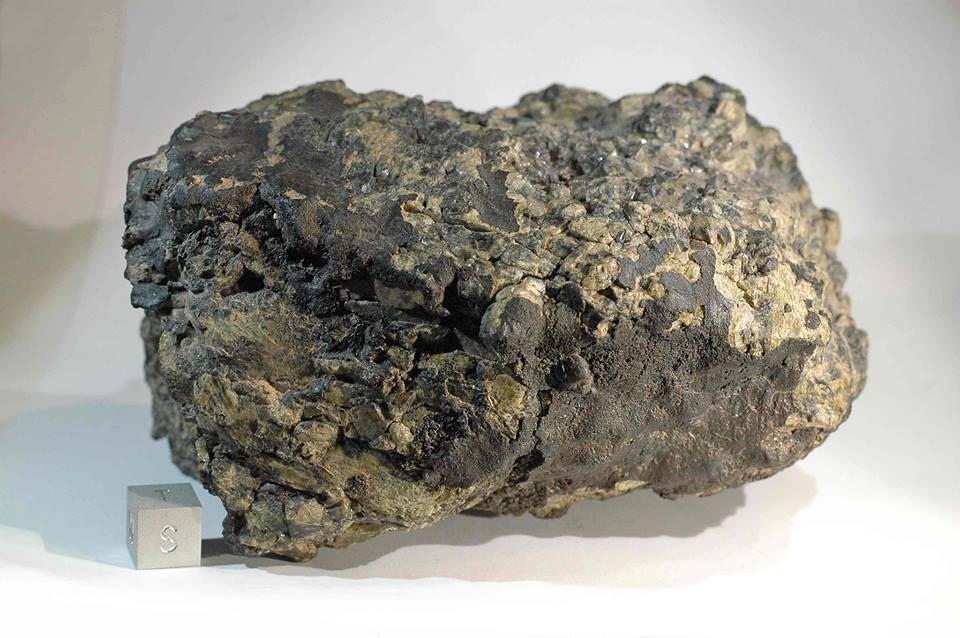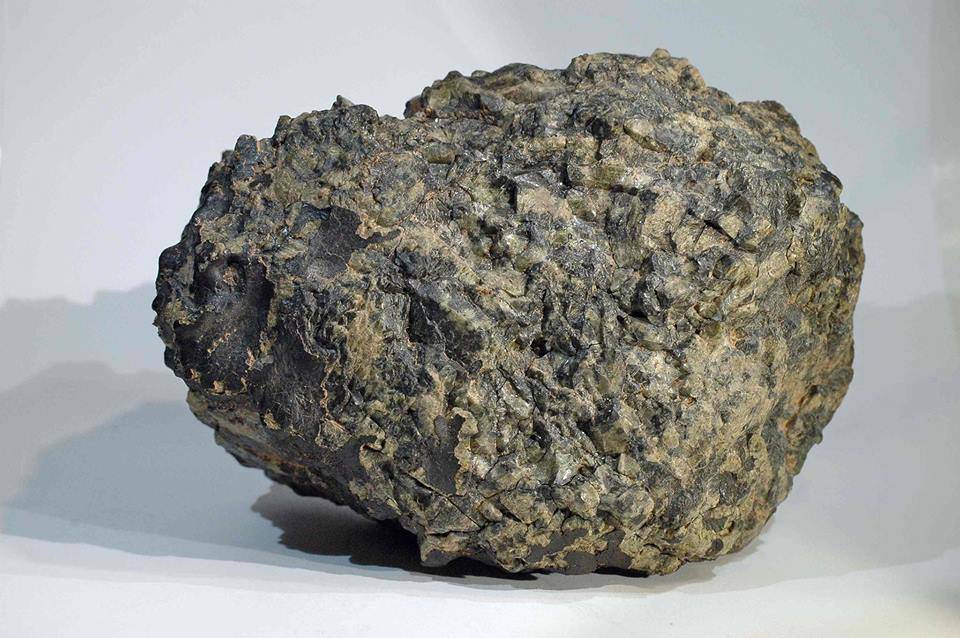DiogeniteDiogenites belong to the evolved achondrite HED group that also includes howardites and eucrites. They are named after the Greek philosopher Diogenes of Apollonia, of the 5th century BCE, who was the first to suggest that meteorites come from outer space (a realization forgotten for over 2,000 years). They are Click on Term to Read More
OrthopyroxeniteA rock composed primarily of orthopyroxene. Non-terrestrial orthopyoxenites include diogenites and a single martian meteorite, ALH 84001, that was found in the Allan Hills region of Antarctica in 1984. ALH 84001 is a cumulate rock consisting of 97% coarse-grained, Mg-rich orthopyroxene, with small amounts of plagioclase, chromite, and carbonate. It Click on Term to Read More
(≥90 vol% orthopyroxeneOrthorhombic, low-Ca pyroxene common in chondrites. Its compositional range runs from all Mg-rich enstatite, MgSiO3 to Fe-rich ferrosilite, FeSiO3. These end-members form an almost complete solid solution where Mg2+ substitutes for Fe2+ up to about 90 mol. % and Ca substitutes no more than ~5 mol. % (higher Ca2+ contents occur Click on Term to Read More)

Fell June 27, 1931
32° 57′ N., 10° 25′ E. At 1:30 A.M., fragments of a rare diogeniteDiogenites belong to the evolved achondrite HED group that also includes howardites and eucrites. They are named after the Greek philosopher Diogenes of Apollonia, of the 5th century BCE, who was the first to suggest that meteorites come from outer space (a realization forgotten for over 2,000 years). They are Click on Term to Read More fell over a radius of 500 meters, 4 km NE of a small village in Tunisia. Local Bedouins immediately collected over 12 kg of mostly minute fragments which were sent to the Muséum National d’Histoire Naturelle in Paris.
Because the larger mass broke up along
mineralInorganic substance that is (1) naturally occurring (but does not have a biologic or man-made origin) and formed by physical (not biological) forces with a (2) defined chemical composition of limited variation, has a (3) distinctive set of of physical properties including being a solid, and has a (4) homogeneous Click on Term to Read More grain boundaries late in its entry, the unbrecciated orthopyroxene (hypersthene) crystals were not melted and
fusion crustMelted exterior of a meteorite that forms when it passes through Earth’s atmosphere. Friction with the air will raise a meteorite’s surface temperature upwards of 4800 K (8180 °F) and will melt (ablate) the surface minerals and flow backwards over the surface as shown in the Lafayette meteorite photograph below. Click on Term to Read More is rare (see photo below), rendering this
meteoriteWork in progress. A solid natural object reaching a planet’s surface from interplanetary space. Solid portion of a meteoroid that survives its fall to Earth, or some other body. Meteorites are classified as stony meteorites, iron meteorites, and stony-iron meteorites. These groups are further divided according to their mineralogy and Click on Term to Read More difficult to recognize. Tatahouine is light olive-green in color, translucent-to-opaque, and is crisscrossed by small black veinlets up to 2 mm wide. Tatahouine has a
cumulateIgneous rock composed of crystals that have grown and accumulated (often by gravitational settling) in a cooling magma chamber. Click on Term to Read More texture with exceptionally large crystals, many reaching 2 cm long. Inclusions of
silicaSilicon dioxide, SiO2.,
troiliteBrass colored non-magnetic mineral of iron sulfide, FeS, found in a variety of meteorites. Click on Term to Read More,
chromiteBrownish-black oxide of chromium and iron (Cr-Fe oxide), Cr2FeO4, found in many meteorite groups. Click on Term to Read More, and minor
metalElement that readily forms cations and has metallic bonds; sometimes said to be similar to a cation in a cloud of electrons. The metals are one of the three groups of elements as distinguished by their ionization and bonding properties, along with the metalloids and nonmetals. A diagonal line drawn Click on Term to Read More occur throughout. Other
diogenitesDiogenites belong to the evolved achondrite HED group that also includes howardites and eucrites. They are named after the Greek philosopher Diogenes of Apollonia, of the 5th century BCE, who was the first to suggest that meteorites come from outer space (a realization forgotten for over 2,000 years). They are Click on Term to Read More with compositions similar to Tatahouine but with various grain textures have since been found, including
NWA 1821 and
NWA 3329.
In 1994, Dr. Alain Carion revisited the strewnfield and recovered many more specimens, raising the total recovered weight to ~13.5 kg. Interestingly, these recent specimens were found to be contaminated by
secondary mineralsMineral that forms through processes such as weathering, and in the case of meteorites can also include pre-terrestrial alteration. Secondary minerals in meteorites that formed during terrestrial weathering include oxides and hydroxides formed directly from metallic Fe-Ni by oxidation, phosphates formed by the alteration of schreibersite, and sulfates formed by Click on Term to Read More including carbonates containing rod-shaped objects, these being similar in size and shape to those found in the
martian meteoriteOver 30 of the meteorites found on Earth almost certainly came from Mars (see http://www.imca.cc/mars/martian-meteorites.htm and http://www2.jpl.nasa.gov/snc/). All but one belongs to the group known as SNC meteorites, which includes the shergottites, nakhlites, and chassignites. SNC meteorites contain minerals that crystallized within the past 1.35 to 0.15 Ga, making them Click on Term to Read More ALH 84001. Other terrestrial weathering effects include increased concentrations of Ba and Sr, and formation of calcite and iron hydroxide.
Diogenites exhibit a wide range of incompatible
elementSubstance composed of atoms, each of which has the same atomic number (Z) and chemical properties. The chemical properties of an element are determined by the arrangement of the electrons in the various shells (specified by their quantum number) that surround the nucleus. In a neutral atom, the number of Click on Term to Read More abundances. Tatahouine, NWA 5480, and MET 00424 represent a subgroup of diogenites exhibiting an HREE enrichment and Eu anomalies considered to be inherited from compositionally distinct parental melts, possibly a product of remelting of previously formed
magma oceanCompletely molten surfaces of terrestrial planets or moons that formed soon after accretion. Samples returned by the Apollo missions provide evidence of a lunar magma ocean, crystallization of which produced a stratified Moon with a low-density crust formed by accumulation of the mineral plagioclase overlying a higher density mantle of Click on Term to Read More orthopyroxene cumulates, some of which were contaminated by partial melts from the eucritic
crustOutermost layer of a differentiated planet, asteroid or moon, usually consisting of silicate rock and extending no more than 10s of km from the surface. The term is also applied to icy bodies, in which case it is composed of ices, frozen gases, and accumulated meteoritic material. On Earth, the Click on Term to Read More and a possible phase of
fractional crystallizationA crystallization process in which minerals crystallizing from a magma are isolated from contact with the liquid. It is a key process in the formation of igneous rocks during the process of magmatic differentiation. Also known as crystal fractionation. Click on Term to Read More (Barrat
et al., 2010). Consistent with this hypothesis is the conclusion by Yamaguchi
et al. (2013) from their analyses of NWA 5480 that this
olivineGroup of silicate minerals, (Mg,Fe)2SiO4, with the compositional endpoints of forsterite (Mg2SiO4) and fayalite (Fe2SiO4). Olivine is commonly found in all chondrites within both the matrix and chondrules, achondrites including most primitive achondrites and some evolved achondrites, in pallasites as large yellow-green crystals (brown when terrestrialized), in the silicate portion Click on Term to Read More diogenite is an
impact melt rockRock that has been made temporarily molten as a result of the energy released by the impact of a large colliding body. Impact melts include small particles, known as "impact melt spherules" that are splashed out of the impact crater, and larger pools and sheets of melt that collect in Click on Term to Read More formed at the bottom of a large basin such as Rheasilvia. In a another study, Fukuoka
et al. (1977) speculated that Tatahouine could be a restite of orthopyroxene cumulates. The
REEOften abbreviated as “REE”, these 16 elements include (preceded by their atomic numbers): 21 scandium (Sc), 39 Yttrium (Y) and the 14 elements that comprise the lanthanides excluding 61 Promethium, an extremely rare and radioactive element. These elements show closely related geochemical behaviors associated with their filled 4f atomic orbital. Click on Term to Read More patterns among the three recognized members of this subgroup are virtually indistinguishable, and they possibly formed from the same parental source
magmaMolten silicate (rock) beneath the surface of a planetary body or moon. When it reaches the surface, magma is called lava. Click on Term to Read More (Barrat
et al., 2010). While it is hypothesized that olivine diogenites like NWA 5480 are cumulates constituting distinct layered magmatic intrusions emplaced into the crust, the unusual features exhibited in NWA 5480 suggest a possible origin as a
mantleMain silicate-rich zone within a planet between the crust and metallic core. The mantle accounts for 82% of Earth's volume and is composed of silicate minerals rich in Mg. The temperature of the mantle can be as high as 3,700 °C. Heat generated in the core causes convection currents in Click on Term to Read More residue; however, analyses by Yamaguchi
et al. (2013) led them to conclude that this diogenite is an impact melt rock formed at the bottom of a large basin such as Rheasilvia.
Newly revised calculations of cosmic-ray exposure ages using the
10Be/
21Ne method have shown that Tatahouine coincides with the major HED peak at 38 m.y. A more detailed scenario for the petrogenesis of the diogenites can be found on the
Johnstown page. To see an alternative classification
systemDefinable part of the universe that can be open, closed, or isolated. An open system exchanges both matter and energy with its surroundings. A closed system can only exchange energy with its surroundings; it has walls through which heat can pass. An isolated system cannot exchange energy or matter with for the diogenites based on mineralogical and petrographical features, proposed by Beck and McSween (2010) and modified by Wittke
et al. (2011), click
here. The specimen of Tatahouine shown above is a 2.9 g fragment containing multiple black shock veins. The photos below show a Tatahouine mass found in 2013 on which remnant
fusionProcess in which two lighter atomic nuclei combine to form a heavier atomic nucleus. Very high temperatures are normally required in order for atomic nuclei to collide with sufficient energy to overcome the Coulomb barrier (their mutual electrostatic repulsions). Fusion that occurs under high-temperature conditions is called thermonuclear fusion. Fusion Click on Term to Read More crust has been preserved, shown courtesy of Sergey Vasiliev.



Photos courtesy of Sergey Vasiliev—
SV-meteorites










